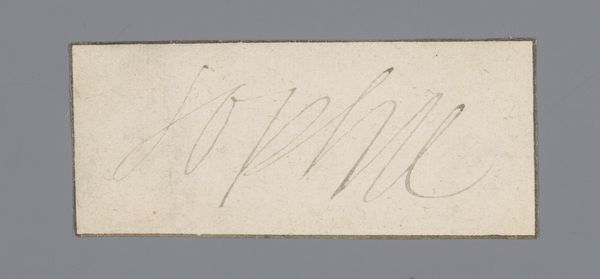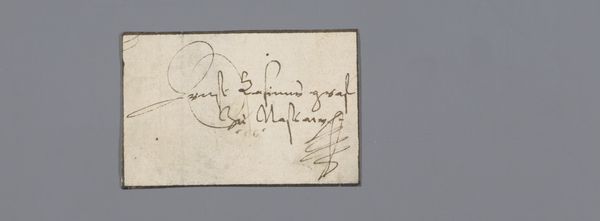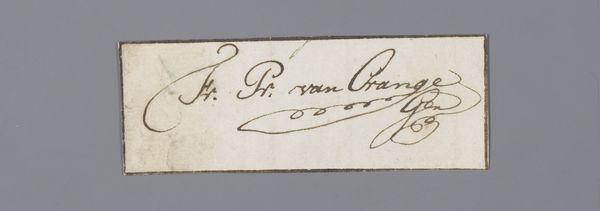
drawing, paper, ink
#
portrait
#
drawing
#
neoclacissism
#
homemade paper
#
script typography
#
hand drawn type
#
paper
#
ink
#
hand-drawn typeface
#
fading type
#
stylized text
#
thick font
#
white font
#
delicate typography
#
historical font
Dimensions: height 2.9 cm, width 9.8 cm
Copyright: Rijks Museum: Open Domain
Curator: Before us, we have "Handtekening Willem Frederik," a drawing from around 1800, housed here at the Rijksmuseum. It's ink on paper. Editor: It's deceptively simple. The graceful script dances across the surface, creating a visual rhythm, a beautiful interplay of thick and thin lines. Curator: The very act of signing, of putting one’s name to something, is laden with meaning. Willem Frederik, later King Willem I, was at a pivotal moment in Dutch history. Consider the power structures, the rise of nationalism. This signature becomes more than just a name. Editor: The composition intrigues me. The signature fills the available space with a somewhat balanced composition that is still quite horizontal, directing my eye across the parchment. What does this constrained signature reveal? Curator: I think it speaks to a specific performance of power. Royalty had to fashion a unique persona even within republican ideals. A delicate dance between entitlement and service. Think of the political turbulence of that time, and the impact of revolutions abroad. It also touches on the idea of how masculinity was crafted and portrayed during that historical period. Editor: Looking at it purely formally, the ink's delicate shade against the paper evokes a certain melancholy. It's aged, faded, a testament to time's passage. There's a fragility that contrasts so strikingly with the expected assertion of authority from a royal figure. Curator: Precisely! And consider, too, how accessible handwriting was then. Before mass literacy programs, the ability to sign your name marked a clear privilege. What was at stake when that signature became an instrument of governance? Editor: Fascinating. From a purely visual standpoint, it's a study in elegance, but when we examine that artistry it gives historical dimension. Curator: Exactly. Hopefully we see that an aesthetic evaluation gives further insight into the subject and context.
Comments
No comments
Be the first to comment and join the conversation on the ultimate creative platform.













